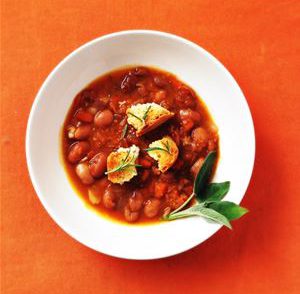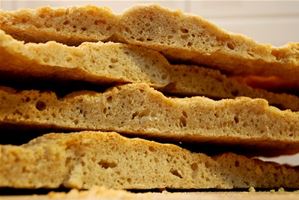Here comes Christmas and the chill of the December air in Florence is sweetened with the enticing aromas of artisan bakers making Tony’s Bread, pan di Toni. This famous fifteenth- century Milanese Christmas cake, known in Italian as panettone, is now the national Christmas cake of Italy. Many competing stories claim to reveal the origins of panettone. Some say Toni invented this yeast-leavened, light, sweet bread perfumed with citrus peel to impress his lover; others say the sweet cake was invented by a nun to impress her fellow sisters. Whichever it is, it is certainly a labour of love, as making panettone is not a quick process.
At this time of year, as soon as my mother in New Zealand begins mixing her Great Aunt Nellie’s Christmas cake in my grandmother’s enormous decorated heavy china bowl, brought down from the high cupboard especially for the occasion, I need to start preparing to make my version of panettone.
The few similarities between the huge dense and heavy cake my mother prepares and my version of Italian panettone are the fruit and the alcohol. Otherwise, the cakes are very different: whereas my mother soaks the dried fruit and citrus peels in ginger ale, I leave them dry at the beginning of the recipe. She starts the procedure at least a month before Christmas; I prepare mine later so I can resist the temptation to eat it before Christmas. My mother can tenderly cajole her dense, heavy slab of cake to soak up a whole bottle of brandy before double-icing it with marzipan and fine sugar frosting; I spend three days carefully creating the lightest natural yeast-leavened panettone possible, and then drown it in vin santo, a Tuscan dessert wine.
Panettone can be toasted for breakfast, eaten with coffee, dipped in vin santo for lunch, enjoyed with prosecco for aperitivo, and served as the closer for dinner, along with amaretto. While some over-the-counter versions of panettone leave me puzzled about why Italians love this tall dry cupola of air and candied fruits, the drunken version I prepare is so delicious it doesn’t sit in the back of the cupboard only to become New Year breakfast fodder, toasted and slathered with butter and homemade jam to remove the dryness. The recipe I offer here yields two cakes: one for the weeks leading up to Christmas and one for the traditional Christmas Eve feast. Enjoy your own panettone this festive season.
Recipe DRUNKEN PANETTONE
Day one: starter dough ingredients
100g butter, melted
400g white flour ‘00′
10g salt
100g white sugar
225ml warm water
125g fresh bakers’ yeast
2 teaspoons of sugar
5 egg yolks
Day two: additional ingredients
300g white flour ‘00′
10g salt
100g butter, melted
5 egg yolks
100g slivered almonds
150g raisins
150g mixed Sicilian candied citrus peel
Grated zest of 1 lemon
1 vanilla pod
METHOD
Starting with the ingredients from day one, begin to prepare: melt the butter, cool to room temperature and set aside; sieve the flour with the salt and sugar and place in a cake mixer with a bread hook. In a steel bowl, measure the water (blood temperature), and add the yeast and two teaspoons of sugar. Leave for 15 minutes or until the yeast is bubbling on the surface of the water. Add the yeast mix to the dry ingredients and mix on slow for five minutes, add the butter and egg yolks and continue to mix for another 15 minutes. At this stage the dough mix should stick to the dough hook and not to the sides of the bowl and should be moist. If not, add a sprinkling of tepid water. Remove this elastic dough and place into a buttered steel bowl three times the volume of the dough. Place a lightweight damp buttered tea-towel (yes, you’ll need to actually butter the towel) over the dough and leave to rest in a warm place and away from drafts for at least 12 hours at 20°C, allowing the dough to more than double in size.On day two, punch the dough down with a floured fist and return to the mixing bowl. Add in the day-two additional ingredients: first the sifted flour and salt, mixing, again using the dough hook. Add the melted butter at room temperature and the egg yolks, and mix on a slow speed for 20 minutes, creating a shiny, elastic dough. Add the almonds, raisins and thinly sliced candied Sicilian orange and lemon peel. Last, split the vanilla pod down the middle and scrape the vanilla beans from the pod into the dough. Mix again for three minutes, then leave to rest in the machine for 30 minutes.Turn the mixture out and divide the dough into two equal parts. Line two panettone pans with panettone paper moulds and fill with the dough. Leave to rise in a warm place for around 10 hours or until the dough has more than doubled in size.
TO BAKE:
Cut an X in the top of each panettone and brush with a tablespoon of warm melted butter. Bake on the lowest rack in the oven at 180°C for around 40 minutes. When a skewer comes out clean, they are ready.Remove from the oven and cool on a cake rack, then leave to dry as per traditional panettone. A couple of days after baking heat up a small bottle of your favourite Tuscan vin santo with 100g of sugar to hand heat, around 50°C, and pour over the panettone to soak it up. Don’t boil the sweet wine as the alcohol evaporates at boiling point. Let the panettone sit in this syrup to soak up and absorb the rest. This makes the whole dry effect disappear and your panettone turn into delicious, syrupy moist treats. Alternately, you can skip the last step and serve your panettone accompanied by a small glass of vin santo.BUON APPETITO AND HAPPY CHRISTMAS!For those who have the time (and courage!) to try this recipe, please feel free to send me your stories on how you enjoyed the recipe and for what occasion.







